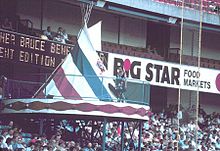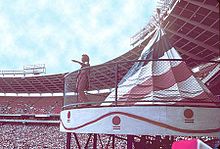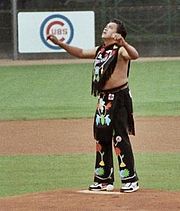- Chief Noc-A-Homa
-
Chief Noc-A-Homa was the original mascot of the Milwaukee and Atlanta Braves from 1950s until 1986. The name was used for the "screaming Indian" sleeve patch worn on Braves jerseys. From at least the early 1960s, while still in Milwaukee County Stadium, until the early 1980s at Atlanta's Fulton County Stadium, this mascot "lived" in a teepee in an unoccupied section of the bleacher seats.
The name was intended to be a playful variation of "Knock a Homer." The mascot's job was to exit his teepee and perform a dance whenever a Braves player hit a home run.
Broadcaster Curt Gowdy, completely missing the point of the mascot's name, once referred to him in a way that sounded more like Japanese: "NO-KAH-HAH-MAH."
In the late 1970s, when the previously mediocre Braves became contenders again, a peculiar superstition arose. When football season approached and the portable bleachers needed to be opened up for the Atlanta Falcons, the teepee was typically removed... and at that point, the Braves would typically start to lose. Superstitious fans claimed that disrupting Noc-A-Homa's home was the cause of their downturn, rather than the team just not having enough depth to sustain first place for the season. After this happened several years in a row, though, the story began to take on a semblance of truth.
The rumor reached a fever pitch in 1982, when the Braves were in first place with a seemingly insurmountable lead. Needing additional seating for sellouts, the Braves removed the teepee and sold tickets to the seats normally supporting it. The Braves promptly lost 19 of their next 21 games and fell to third place.[1] When Braves management put the teepee back in place, the Braves went back to first place and ultimately won the Western division that year.
Late in Noc-A-Homa's duration, Hopewell, Virginia native Kimberly Ann Calos was introduced as "Princess Win-A-Lotta"
The best-known Noc-A-Homa was Levi Walker, Jr., an Ottawa native and an Odawa Indian. In 1986, Walker and the Braves mutually agreed to end their relationship due to disagreements about pay and missed dates.[1] Walker petitioned the club to revive his role during the Braves' 1991 magical pennant run, but the Braves' management declined. During the late 1970s, the Braves also had a green mascot called Bleacher Creature.
Noc-a-Homa was eventually replaced as the mascot by the characters Homer and Rally. This has not, however, circumvented the introduction of other Native American-inspired traditions for Braves fans, such as the "Tomahawk Chop," adapted with the arrival of Florida State University multi-sport star Deion Sanders from Florida State's popular war chant.
See also
- Native American mascot controversy
- List of sports team names and mascots derived from Indigenous peoples
- List of ethnic sports team and mascot names (all ethnicities)
References
- ^ a b "Mascot Won't Return". the New York Times. 1986-01-19. http://query.nytimes.com/gst/fullpage.html?res=9A0DE5DE113CF93AA25752C0A960948260. Retrieved 2007-06-30.
Atlanta Braves Formerly the Boston Red Stockings, Boston Red Caps, Boston Beaneaters, Boston Doves, Boston Rustlers, Boston Bees, Boston Braves and the Milwaukee Braves · Based in Atlanta, Georgia Franchise History (Boston) · Braves Museum & Hall of Fame · Award winners & league leaders · Records · No-hitters · Seasons · Owners and executives · Managers · Opening Day Starters (Atlanta · Boston and Milwaukee) · First-round draft picks · Broadcasters · Atlanta Braves Radio NetworkBallparks South End Grounds · Congress Street Grounds · South End Grounds · Fenway Park · Braves Field · Milwaukee County Stadium · Atlanta-Fulton County Stadium · Turner Field
Spring training: St. Petersburg Athletic Park · McKechnie Field · Municipal Stadium · Champion StadiumCulture 1897 Temple Cup · Continental League · Braves Bleacher Creature · Chief Noc-A-Homa · Homer · Rally · Braves TBS Baseball · Tomahawk Buzzcut · #715 · The Slugger's Wife · Francisco Cabrera game · Grand Slam Single · Randy Johnson's perfect gameRivalries Retired numbers Key personnel Owner: John C. Malone (Liberty Media) · General Manager: Frank Wren · Club President: John Schuerholz · Manager: Fredi GonzálezWorld Series
Championships (3)National League
Championships (17)National Association
Championships (4)Other Titles Minor league
affiliatesAAA: Gwinnett Braves AA: Mississippi Braves A: Lynchburg Hillcats · Rome Braves Rookie: Danville Braves · Gulf Coast League Braves · DSL BravesOther assets Seasons (140) 1870s 1880s 1890s 1900s 1910s 1920s 1930s 1940s 1950s 1960s 1970s 1980s 1990s 2000s 2010s 2010 • 2011 • 2012Categories:- Major League Baseball team mascots
- Atlanta Braves
- Milwaukee Braves
Wikimedia Foundation. 2010.




